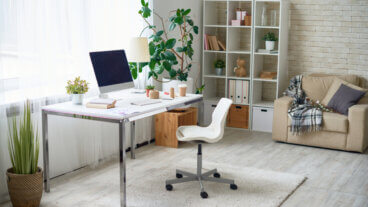How to Soundproof Your Home

Enjoying peace and quiet without the disturbances generated by the outside or external noise can be achieved if you soundproof your home. Doing this adds value to your home and guarantees the well-being of everyone who lives there.
Therefore, in this article, we’re going to explain how you can protect your home from outside noise. Interested to learn more? Keep reading!
Soundproof your home
If you want to soundproof your home, the first thing you have to consider is the materials you’ll need. This includes materials for the walls, windows, and even the floors. It’s also necessary to think about the decorative elements that you’ll need which will contribute to achieving this objective.
Materials to soundproof your home
If you’re building your home from scratch, you have to think about building with materials that already have soundproofing qualities. One of the most popular choices for walls is mineral wool, a porous rock and glass material with the ability to absorb outside noise.
Among other options is double-glazing for glass, suitable for soundproofing windows. These crystals have a minimum thickness of six millimeters that isolates the interior from the exterior and vice versa. You must also consider using curtains for windows, keeping in mind that thicker textiles are better when it comes to soundproofing.
Soundproof your home: flooring

When you want to isolate your home from noise, you also need to consider your flooring. Normally a surface that’s left aside, the correct flooring can absorb noise. If you have floating floors or laminate, you can install an insulating base made from rock wool panels.
It’s also wise to think about accessories such as thick fabric rugs that absorb noise. These are especially useful if you live in a multi-storey property, with several floors.
Wall cladding to isolate noise
Another option to soundproof your home is using coatings made of materials such as cork, wood, or polyurethane panels. In addition to looking great, these materials prevent external noise from penetrating your home.
Decorative accessories
Options such as bookshelves are essential for not only storing your books but also for isolating noise. They create a barrier between neighboring and adjoining walls by interrupting the sound. This also applies to classrooms and studios.
When it comes to bedrooms, it’s effective to use a good headboard made from a tapestry or thick fabric. The ideal headboard can be padded and upholstered–the more layers the better.
Accessories that support soundproofing in rooms such as the bedroom and the living room include cushions, thick curtains, sofas, and poufs.
Soundproof your ceiling
Ceiling coatings for soundproofing have a double function: to isolate sounds from one floor to another and to prevent external sounds from the top floor, such as rain.
To achieve this, you’ll need to use wooden slats or create a false ceiling with insulating material between it and the original ceiling. Wooden slats have the added benefit of insulating the home during cold seasons.

What do you need to soundproof your home?
As you’ve learned, there are different ways to soundproof your home. You can choose from a variety of coatings, materials, and decorative elements that’ll help to reduce noise.
Remember, the more elements you have in your home, such as furniture and textiles, the more you’ll help to minimalize noise and prevent sound reverberation. An almost empty home is an acoustic box that’ll encourage sound to bounce. If you never thought of it this way, it’s something to consider for the future.
Oh, don’t forget that doors also help to isolate noise too! A solid door in the bedroom can be a useful way to prevent outside noise from coming inside.
Enjoying peace and quiet without the disturbances generated by the outside or external noise can be achieved if you soundproof your home. Doing this adds value to your home and guarantees the well-being of everyone who lives there.
Therefore, in this article, we’re going to explain how you can protect your home from outside noise. Interested to learn more? Keep reading!
Soundproof your home
If you want to soundproof your home, the first thing you have to consider is the materials you’ll need. This includes materials for the walls, windows, and even the floors. It’s also necessary to think about the decorative elements that you’ll need which will contribute to achieving this objective.
Materials to soundproof your home
If you’re building your home from scratch, you have to think about building with materials that already have soundproofing qualities. One of the most popular choices for walls is mineral wool, a porous rock and glass material with the ability to absorb outside noise.
Among other options is double-glazing for glass, suitable for soundproofing windows. These crystals have a minimum thickness of six millimeters that isolates the interior from the exterior and vice versa. You must also consider using curtains for windows, keeping in mind that thicker textiles are better when it comes to soundproofing.
Soundproof your home: flooring

When you want to isolate your home from noise, you also need to consider your flooring. Normally a surface that’s left aside, the correct flooring can absorb noise. If you have floating floors or laminate, you can install an insulating base made from rock wool panels.
It’s also wise to think about accessories such as thick fabric rugs that absorb noise. These are especially useful if you live in a multi-storey property, with several floors.
Wall cladding to isolate noise
Another option to soundproof your home is using coatings made of materials such as cork, wood, or polyurethane panels. In addition to looking great, these materials prevent external noise from penetrating your home.
Decorative accessories
Options such as bookshelves are essential for not only storing your books but also for isolating noise. They create a barrier between neighboring and adjoining walls by interrupting the sound. This also applies to classrooms and studios.
When it comes to bedrooms, it’s effective to use a good headboard made from a tapestry or thick fabric. The ideal headboard can be padded and upholstered–the more layers the better.
Accessories that support soundproofing in rooms such as the bedroom and the living room include cushions, thick curtains, sofas, and poufs.
Soundproof your ceiling
Ceiling coatings for soundproofing have a double function: to isolate sounds from one floor to another and to prevent external sounds from the top floor, such as rain.
To achieve this, you’ll need to use wooden slats or create a false ceiling with insulating material between it and the original ceiling. Wooden slats have the added benefit of insulating the home during cold seasons.

What do you need to soundproof your home?
As you’ve learned, there are different ways to soundproof your home. You can choose from a variety of coatings, materials, and decorative elements that’ll help to reduce noise.
Remember, the more elements you have in your home, such as furniture and textiles, the more you’ll help to minimalize noise and prevent sound reverberation. An almost empty home is an acoustic box that’ll encourage sound to bounce. If you never thought of it this way, it’s something to consider for the future.
Oh, don’t forget that doors also help to isolate noise too! A solid door in the bedroom can be a useful way to prevent outside noise from coming inside.







